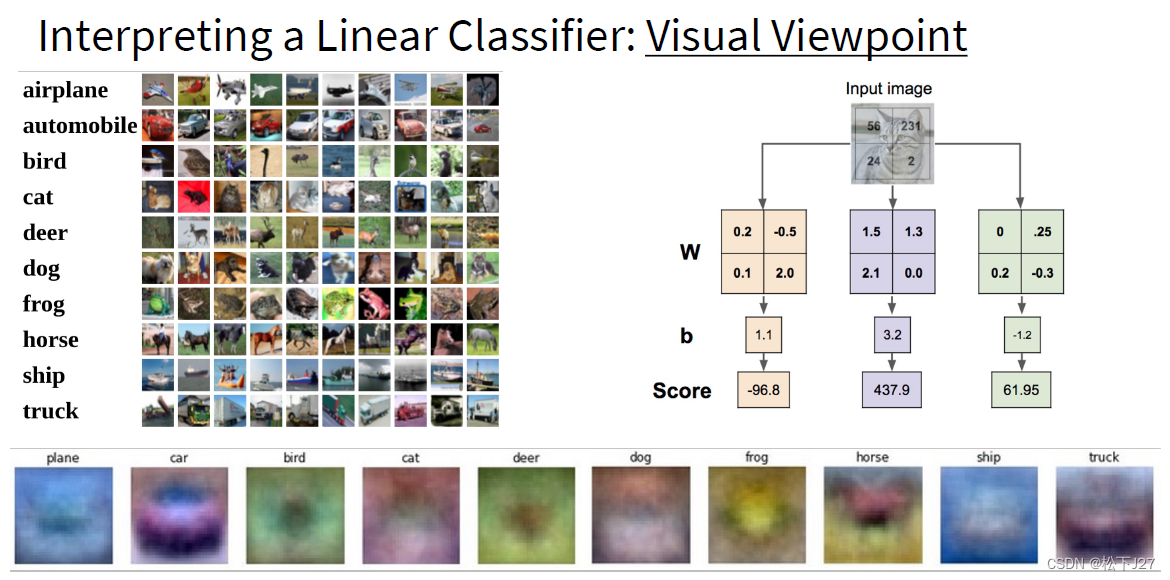本文主要是介绍Stanford CS231N,希望对大家解决编程问题提供一定的参考价值,需要的开发者们随着小编来一起学习吧!
文章目录
- 1 introduction to convolutional neural network
- 2 Image classification pipeline
- 2.1 nearest neighbors classifier/KNN
- 2.2 Linear classification
- 3 loss function and optimization
- 3.1 loss function of multclass SVM
- 3.2 Softmax Classifier(Multinomial Logistic Regression)
- 3.3 optimization
- 3.4 Image Features
- 4 Introduction to neural networks
- 4.1 backforward propagation
- 4.2 neural network
- 5 convolutional neural networks
- 5.1 convolutional layer
- 5.2 pooling layer
- 6 training neual network 1
- 6.1 activation function
- 6.2 weight initialization
- 6.3 batch normalization
- 7 training neual network 2
- 7.1 hyperparameter search
- 7.2 fancier opitimization
1 introduction to convolutional neural network
image segmentation:
object recognition
face detection
SIFT: some features tend to remain diagnostic and invariant to changes
PASCAL visual object challenge
ImageNet:22k categories and 14M images: ImageNet large-scale visual recogniton challenge
http://cs231n.github.io/gec-tutorial
2 Image classification pipeline
challenge:
semantic gap(语义)
viewpoint variation
illumination
deformation
occlusion
intraclass variation
data-driven approach
- collect a dataset of images and labels
- use machine learning to train a classifier
- evaluate
CIFAR10
10 classes
50,000 training images
10,000 testing images
each image is 32323
2.1 nearest neighbors classifier/KNN
时间复杂度:
Train: O(1)
predict: O(N)
改进:KNN: K-Nearest Neighbors,按照majority vote原则
缺点:
very slow ate test time
distance are not informative
距离
Manhattan distance:正方形
Euclidean distance:圆形
超参数hyperparameter: depend on problem and data
Setting Hyperparameters: cross-validation
2.2 Linear classification
f ( x , W ) = W x + b f(x,W)=Wx+b f(x,W)=Wx+b
http://cs231n.github.io/assignments0217
3 loss function and optimization
3.1 loss function of multclass SVM
cs229会讲SVM
L i = ∑ j ≠ y i { 0 i f s y i > s j + 1 s j − s y i + 1 L_i=\sum_{j \neq y_i}{\left\{\begin{matrix} 0& if s_{y_i}>s_j +1\\ s_j-s_{y_i}+1& \end{matrix}\right.} Li=j̸=yi∑{0sj−syi+1ifsyi>sj+1
= ∑ j ≠ y i m a x ( 0 , s j − s y i + 1 ) =\sum_{j \neq y_i}{max(0,s_j-s_{y_i}+1)} =j̸=yi∑max(0,sj−syi+1)
where s y i s_{y_i} syiis the predicted score of true category
损失函数最小值是0,最大值是正无穷


3.2 Softmax Classifier(Multinomial Logistic Regression)
L i = − l o g P ( Y = k ∣ X = x i ) = − l o g e s k ∑ j e s j L_i=-logP(Y=k|X=x_i)=-log\frac{e^{s_k}}{\sum_j{e^{s_j}}} Li=−logP(Y=k∣X=xi)=−log∑jesjesk
希望 P ( Y = k ∣ X = x i ) P(Y=k|X=x_i) P(Y=k∣X=xi)接近1,所以希望 − l o g P ( = k ∣ X = x i ) -logP(=k|X=x_i) −logP(=k∣X=xi)接近0
损失函数都最大值是正无穷,最小值是0
3.3 optimization
- random search: 最愚蠢最简单的做法
- 梯度下降:便利所有训练集计算得到梯度
while True:weights_grad=evaluate_gradient(loos_fun,data,weights)weights+=-step_size*weights_grad
其中step_size就是学习率
- 随机梯度下降:用一部分(x,y)来预估gradient,称为一个batch,以此减少计算量
3.4 Image Features
分类器的输入最好是图像的特征,而不是像素点
坐标变换、有向梯度直方图、词袋
4 Introduction to neural networks
4.1 backforward propagation

patterns in back gradient
max gate: 只传给最大的那个值
gradients add at branches
对于graph structure要有forward()和backward()
4.2 neural network
一个简单的2-layer neural network: f = W 2 m a x ( 0 , W 1 x ) f=W_2 max(0,W_1 x) f=W2max(0,W1x)
5 convolutional neural networks
5.1 convolutional layer
5.2 pooling layer
downsampling
- max pooling
- average pooling
6 training neual network 1
6.1 activation function

6.2 weight initialization
W初始化太大:激活函数会饱和
W初始化太小:输出太小,约等于0
最好的情况是每一层都是高斯分布的

6.3 batch normalization
usually inserted after fully connected or convolutional layers, and before nonlinearity
x ′ = x − E [ x ] v a r [ x ] x'=\frac{x-E[x]}{\sqrt{var[x]}} x′=var[x]x−E[x]
7 training neual network 2
7.1 hyperparameter search

7.2 fancier opitimization

noise can be averaged
这篇关于Stanford CS231N的文章就介绍到这儿,希望我们推荐的文章对编程师们有所帮助!









